What we’re thinking
We’re breaking free of the historical view of value and value creation.
Focussing on creating value is constraining. Really, it is progress (towards a more desirable state) that we are all trying to make.
By understanding progress we can build an operating system. Levers such as origins, progress sought, progress offered, alongside comparisons of progress judgements offer us the ability to improve progress (innovation).
Value emerges incrementally through making progress. Such emerged value needs to be recognised by a seeker – a process akin to revenue recognition – for it to be meaningful to them.
If progress is hampered or not as expected, we might experience value destruction.
Key concept: Value emerges from progress and needs recognising to be meaningful
Now we arrive at the progress economy’s model of value. We’ll build on value-in-use, inheriting how that addresses the growth blind spots in our traditional value-in-exchange model. Through this approach, we seek to define and measure “value” in a way that encourages systematic innovation.
Or rather, we won’t.
It turns out that focusing on and defining “value” is putting the cart before the horse, as the saying goes. Instead, we shall pivot our attention to progress – a verb, state, noun, and state transition. Our observation is that:
value emerges from progress being made.
Therefore we should primarily focus on making, and improving, progress. In our model, value is a judgement of that progress. Primarily it is:
- a trailing indicator of progress reached
- an indicator of potential progress that could be reached
However, to be meaningful any emerged value needs to be recognised by the progress seeker. Recognition often happens slower than emergence. At the end of an activity, for example, or even not until all progress is made.
Welcome to the value-through-progress model. It has the following benefits and constraints:
benefits
- inherits all benefits from value-in-use
- defines a clear, actionable, definition of progress/value
- enables the nature of value to be understood and harnessed
- explains market fit and markets/ecosystems
- enables the construction of a 4-layer operating system of progress
- restores a link to price – shining light on business model innovation
constraints
- value is complex to understand
- progress and value are often uncountable
- easy to over apply the inherent need for interactions
Leveraging a model that focuses on progress leads to clearer reasoning about desires, mechanisms, decision processes and hinderances to making progress. These are the levers for more systematic innovation.

Before we delve into how we define, create, and measure progress, along with its implications for innovation, let’s first briefly explore what progress truly is.
What is progress?
At its core, progress is a verb, a move over time to a more desirable state.
progress: moving over time to a more desirable state
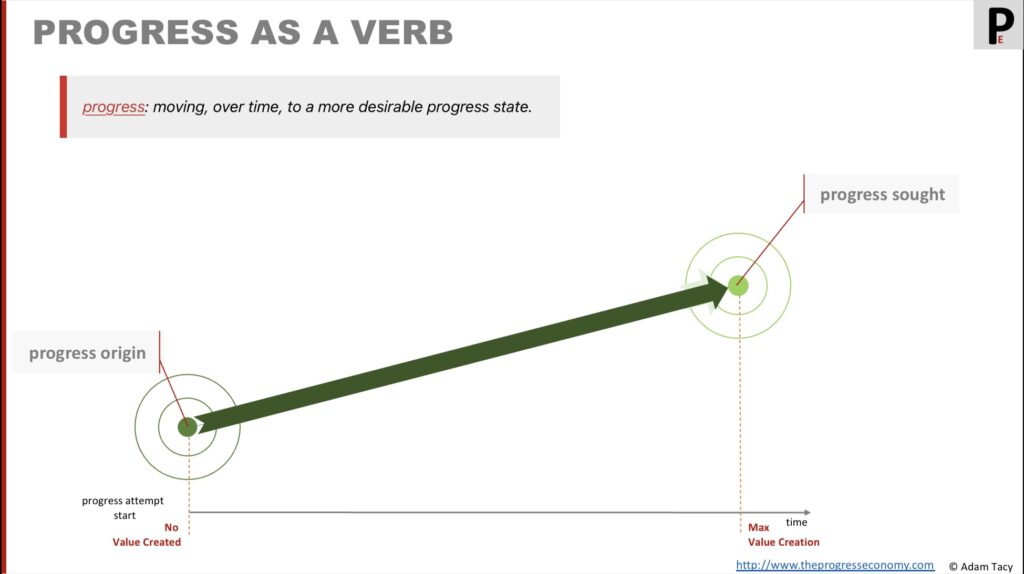
It is a progress seeker that attempts these moves.
We call a seeker’s current progress state their progress origin, and the more desirable progress state they wish to reach we call progress sought. Both of these progress states capture functional, non-functional, and contextual aspects.
As an aside, when I draw diagrams of progress, such as above, my intention is any progress state to the left of another is a state of less progress. Here it is hopefully obvious that progress origin has less progress than progress sought.
Conceptually, we can also view progress as a series of state transitions from progress origin to progress sought, each transition being the result of a progress-making activity (a successful integration of resources).
However, seekers struggle to progress if they lack the necessary resources – skills, knowledge (including knowledge of the necessary progress-making activities), tools, time, physical attributes such as strength, etc.
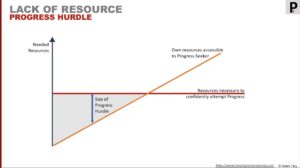
We call this a progress hurdle, specifically the lack of resource progress hurdle. It is a hurdle, not a barrier, as seekers may attempt progress despite their unique and phenomenological view of the hurdle’s height (though, naturally, higher hurdles lower the probability of a successful attempt). And the lack of resource hurdle is seen as the fundamental hurdle in the progress economy.
Addressing this hurdle is where progress helpers step in.
progress helpers and their propositions
Progress helpers – individuals, organisations, ecosystems – offer progress propositions: offers to help make progress. They help seekers move from the proposition’s origin to a progress state of progress offered. Such propositions are bundles of supplementary resources, namely:
- a proposed series of progress-making activities – you might better recognise as instructions, manuals, recipes, ways of working, contracts etc
- a progress resource mix – proposition specific mix of external facing employees, systems, data, goods, physical resources, locations
Progress propositions sit on a continuum between enabling and relieving propositions. With where they sit relating to who performs the majority of the progress-making activities.
Since we’re building on service-forward logics we should remember that goods have a new role. They freeze service provision, allowing for it to be distributed in time and space. Service is unfrozen through acts of resource integration using the goods.
Goods are distribution mechanisms for service provision
#3
We similarly see service as being exchanged rather than value. And we are particularly interested in the effort involved in exchanges being equitable. Practically this means the effort I given in service to you, I expect to feel is reciprocated in service from you (most often indirectly, though sometimes directly). I’ll signal that effort through price, you may reciprocate service in service or service credits (of which money has been a successful implementation).
A service that offers to 100% match a seeker’s progress origin and progress sought usually requires maximum helper effort. That implies maximum effort, and therefore a premium on service exchange effort. These expectations of effort exchange lead to an additional progress hurdle equitable exchange.
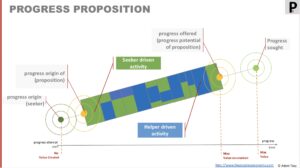
Helpers often segment their market to increase share and reduce the above hurdle. Our model tells us this segmentation is best performed using generalisations of individual seeker’s progress origin and progress sought. The relative differences are something a seeker considers when choosing a proposition to engage with.
In fact, propositions introduce five new progress hurdles – equitable exchange as well as adoptability, resistance, misalignment on continuum, lack of confidence. They may also not sufficiently address the original lack of resources.They may also introduce new lack of resource – for example, the offering may require the seeker to use new skills.
progress and value
How do progress and value relate?
Well, I believe a seeker gets their maximum value when they reach their progress sought. Working back from there we can map the other progress states we are interested in to levels of value. I show this on the following diagram.
There’s a lot to unpack about progress and value, and that’s what we’ll do in the rest of this site. If you want to dig deeper into progress already, feel free to jump into how we define progress.
Right, it’s time to get into the comfy sofa, grab your favourite drink, and start exploring how we arrive at the above diagram by looking at how progress is made, how value emerges, and why that emerged value needs to be recognised for it to be meaningful. Buckle up, understanding value through progress is complex, but ultimately, rewarding!.
Value-through-progress
The challenge with a sole focus on value is, as we saw in the in-exchange model, it is hard to define and therefore obscures our view.
Progress, on the other hand, is clearly definable. And my proposition is that reaching progress sought means maximum value has emerged/been created for the seeker.
Therefore, we should focus on making, and improving, progress. Value is something that emerges from that progress.
Let’s reframe our value model to this type of thinking.
value-through-progress: a view of value creation that primarily focusses on making progress. It sees value as a secondary aspect, emerging as progress is made, and which needs to be recognised by the progress seeker – a process akin to revenue recognition – before it is meaningful to them.
In essence, a progress seeker moves from their current state to their more desired state through a number of progress-making activities. Value emerges incrementally along this journey, starting from zero at the progress origin, emerging as the activities are performed, and reaching its peak at the progress sought state.
Maximum value emerges for a seeker engaging a proposition when reaching the progress offered state. This may be less value than at progress sought since a progress offered is often a compromise.
In addition, a seeker’s perception (recognition) of value often doesn’t align with the value emerging timeline. Whilst value emerges with progress, it might not be meaningful to a seeker until, say, a progress-making activity succeeds. If the activity fails, even just before the end, the seeker may perceive no increase in value.
We call the process of a seeker converting emerged value into meaningful value: value recognition.
Here’s a way to visualise progress and the emergence of value and value recognition. Don’t worry, we’ll look at value recognition shortly.

With this in mind, we’ll begin our exploration of value-through-progress by looking at how we define value.
defining value – a dynamic collection of progress comparisons
Back in the value-in-use model, we saw value as an increase in a beneficiary’s (or wider service system’s) well-being but acknowledged that well-being was challenging to define. Although we did note that was an improvement on “maximum price a customer is willing to pay” from value-in-exchange.
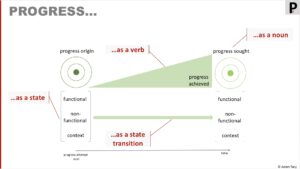
Shifting our focus to progress offers a more definable concept. We view progress as a state, encompassing functional, non-functional, and contextual elements. We also see progress as being verb/state transition, indicating movement from one state to another. On top, we name specific states to serve as waypoints on these journeys.
We find that seekers judge aspects of progress, often expressing them in terms of value. When they say, “This tool is valuable,” they mean, “This tool (proposition) is most likely to be helpful when I attempt progress from my current origin to my desired state of progress sought.” Or “this tool (proposition) best helped me…” progress (and thus value).
What does this mean for value? Value for a customer is a measure of the ability to, and achievement of, progress to their more desirable state (progress sought)
In practical terms value is a collection of progress comparisons between an actor’s specific judgements of progress and their expectations. These comparisons are uniquely and phenomenologically determined by the actor (as per service-dominant logic) and vary at different phases of progress.
value: a dynamic collection of progress comparisons uniquely and phenomenologically made by a participating actor, before, during, and after a progress attempt.
As an example, when looking to start a progress attempt, a seeker compares their judgement of potential progress against their expectation of progress sought. The closer the comparison, the greater their perception of value. Progress comparisons and value judgements are essentially two sides of the same coin.
It is the subjective, unique, phenomenological, and multi-faceted nature, that brings complexity to understanding value. Yet it is precisely through understanding this complexity we find the systematic levers enabling us to systematically drive growth/innovation.
By definition, there are three fixed points of value we come across in a progress attempt:
- zero value emerges before a progress attempt starts
- max value has emerged when a seeker reaches their individual progress sought
- max co-created value has emerged when a seeker reaches a proposition’s progress offered (this is likely lower – to the left – of the max-value point)
what are these progress comparisons / value judgements?
There are a number of progress comparisons that make up value. They differ through the progress attempt, that’s why we define value as a dynamic collection of comparisons.
We can best visualise the various progress comparisons by grouping them into three stages: before, during, and after a progress attempt. As well as grouping those made when a seeker makes a solo progress attempt and those additional/updated comparisons when engaging a proposition.

Before a progress attempt, actors assess whether they feel sufficient progress could be made. The comparisons are:
- progress potential vs progress sought
- height of lack of resource progress hurdle vs tolerance of lacking resource
- progress offered vs progress sought*
- seeker’s progress origin vs proposition’s origin*
- height of five proposition related progress hurdles vs tolerance of those hurdles*
* when engaging a proposition
During the attempt, actors focus on value recognition, and regularly comparing progress made and remaining progress potential against their expectations. They also continually judge all progress hurdles (propositions introduce five additional hurdles).
- value recognition
- progress reached vs progress expected
- (remaining) progress potential vs progress sought
- height of lack of resource progress hurdle vs tolerance of lacking resource
- (remaining) progress potential vs progress offered*
- height of five proposition related progress hurdles vs tolerance of those hurdles*
* when engaging a proposition
One thing we need to be aware of is that progress sought can evolve during the attempt. Progress offered may also evolve if the helper responsively updates their offering. This is due to experience gained by actors in this and/or other attempts being made (even in other markets/industries).
There is also an alignment sub-phase that may happen prior to progress proper being made. In this period, seeker and helper attempt to reduce seeker’s value judgement gaps and hurdle judgements.
After a progress attempt there is a final judgement of progress reached.
- progress reached vs progress expected
- height of equitable exchange hurdle
- potentially heights of the five other progress hurdles
Finally, what an actor learns during attempts gets feedback to the start of other attempts. And for a seeker that means both attempts for the same aspect of progress sought and other aspects.
Who determines value?
When it comes to who determines value, we hold with the service-dominant logic view that it is the seeker (beneficiary).
value is always uniquely and phenomenologically determined by the beneficiary
#10
We therefore refer to the progress comparisons made by a progress seeker as value judgments. As mentioned earlier, value judgments and progress comparisons are two sides of the same coin.
However, we must recognise the practicality that progress helpers may make their own progress comparisons relating to a specific seeker’s attempt. These include judging progress potential, the likelihood of successful equitable exchange, and the progress reached. The results of such progress comparisons can lead to two actions: helpers may either withdraw their supplementary resources or add additional resource to try to recover from value destruction (hindering of progress).
It’s important to keep in mind that helper-made progress comparisons are independent of, and do not directly influence, a seeker’s value judgments. To avoid confusion, we will continue calling them progress comparisons.
On the next page we’ll look at how value is measured, created, and potentially destroyed.
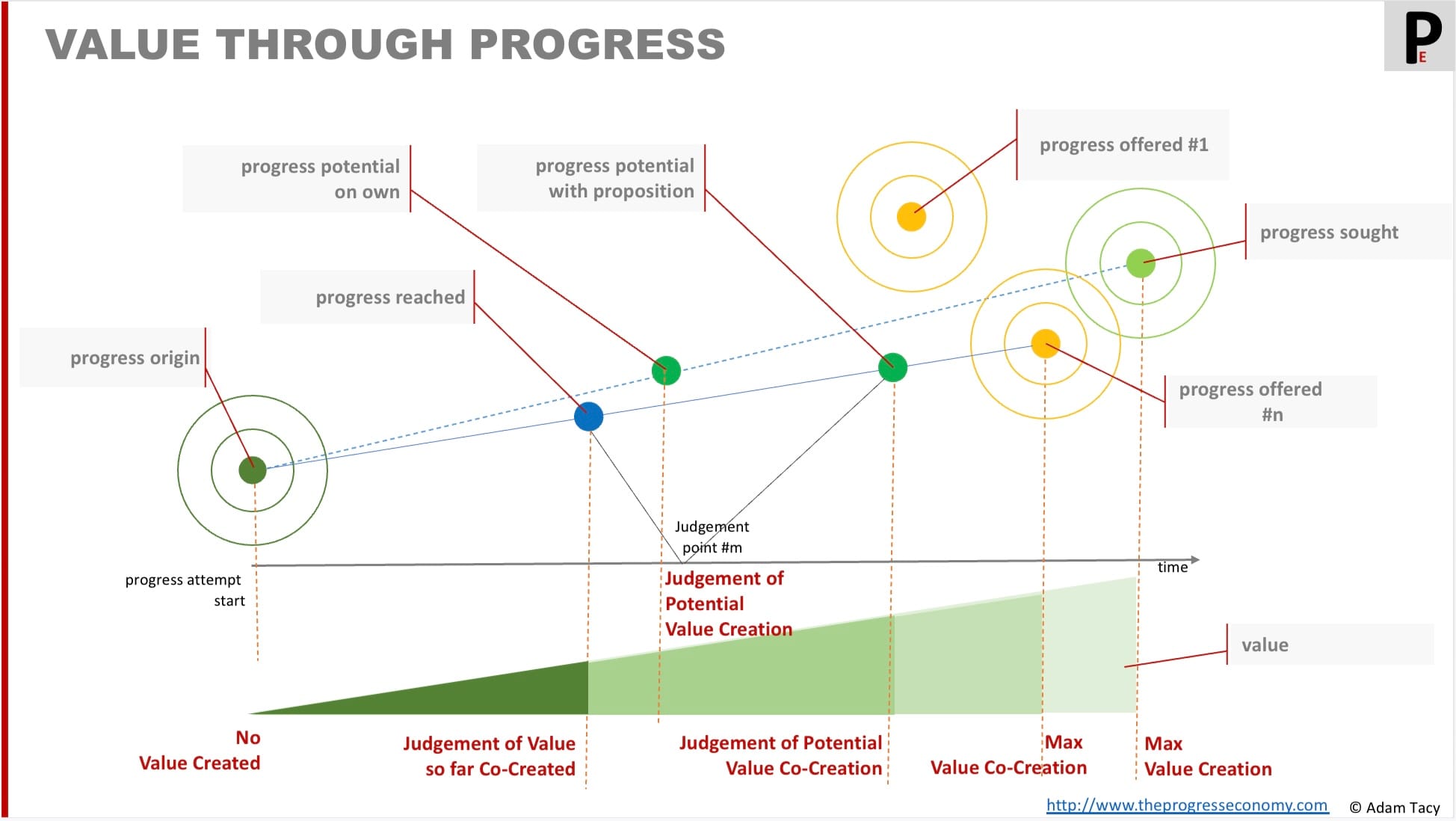

Let’s progress together through discussion…